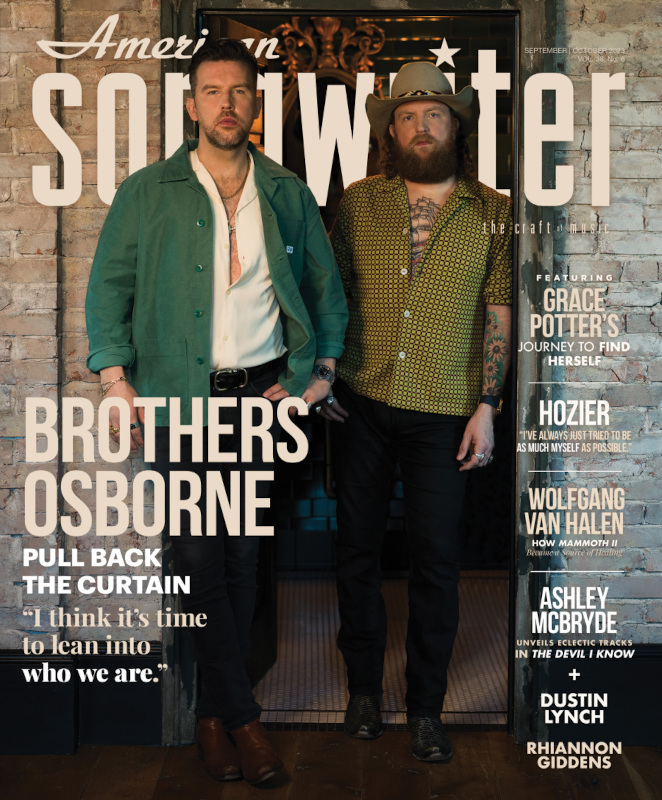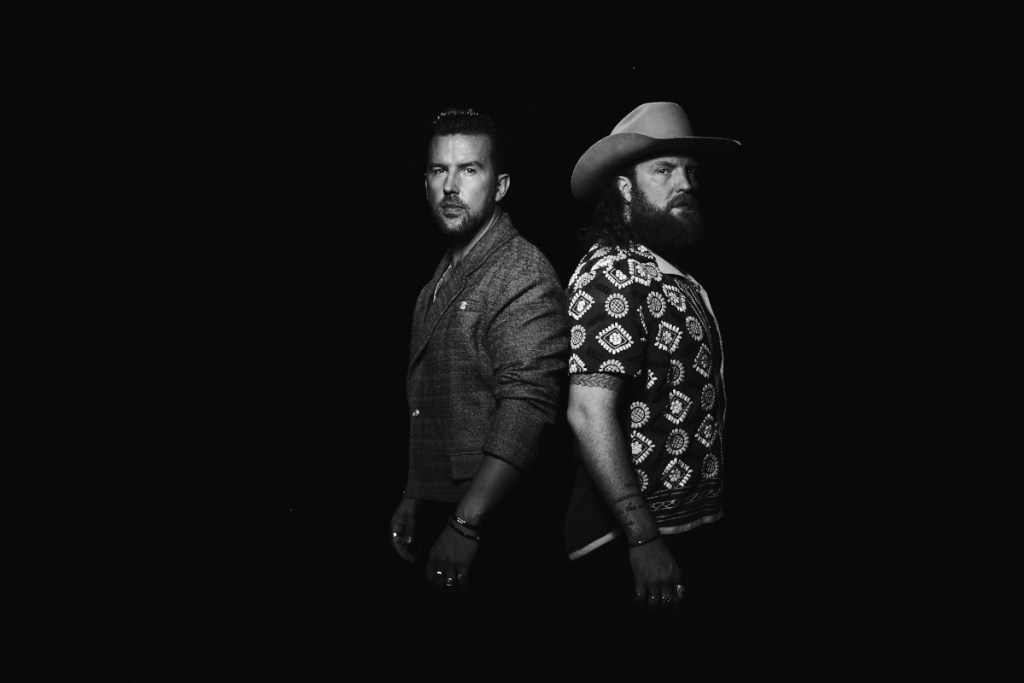Brothers Osborne have gone through a period of personal and creative metamorphosis since the release of their 2020 album Skeletons. Within those three years, lead vocalist T.J. Osborne came out as a gay man—something only a handful of country artists have chosen to speak about publicly. His brother, seasoned songwriter and guitarist John Osborne became a father to twins with his wife and fellow artist Lucie Silvas after years of infertility treatments.
Videos by American Songwriter
With such significant shifts in their personal lives, it feels natural that the sound of Brothers Osborne would change along with them.
The brothers may have had a specific vision in mind going into their fourth studio album, but they went through the process with more creative and mental freedom than ever. The result is both familiar and foreign, a collection of complex soundscapes that still leave room for the listener to grasp every line.
“With our previous records, we would go to a lot of different places. This time we thought, ‘Let’s really try to hone in on one specific sound because we’ve never done that before,'” T.J. Osborne tells American Songwriter. “As we wrote it, the opposite actually happened. Sonically, [the album] goes to more places than we’ve ever done before. It’s a very wide spectrum. You can definitely hear our influences from all different genres and eras.”

Most of the songs that make up Brothers Osborne, available September 15, were written shortly before the duo began the recording process. Although they had plenty of unreleased material to choose from, they wanted to feel fully confident about the record’s track list before they even set foot in the studio.
“The cream always rises to the top,” T.J. says of their song selection process. “That being said, I think you hear us more than ever because there’s so much changing around us, but the constant always being John and I, there is this common thread there that I think is highlighted.”
That common thread, which held steady through those shifting winds, is also what led the brothers to choose this project to become their first self-titled LP. Their album art shows both of their faces, half obscured in shadow, front, and center. It’s a starkly different visual compared to the covers of their two previous albums, which only show their silhouettes in the distance.
“Without us even really realizing we were doing it, [we were] maybe adding some mystery there, by accident,” T.J. explains. “For me, there are obvious reasons. Being closeted the whole time, I always really liked everything being at arm’s length and never coming in too close to me.”
Now that those figurative curtains have been pulled back, there are no more distractions, no more fog clouding their reflections in the mirror.
“Instead of always kind of having the veil there, I think it’s time to remove that and lean into who we are,” T.J. continued. “I thought we did that with this music, and so we decided to visually do the same thing. We’ve got nothing to hide.”
That sense of comfortable confidence echoes through all eleven tracks on Brothers Osborne, which builds off the duo’s trademark meld of classic Southern rock and polished modern country. With the help of award-winning producer Jay Joyce, they had built a sound that appealed to both average country radio listeners and those looking for something a little different, the kinds of songs that now often get lumped under the catch-all term of “Americana.”
This time, the brothers were ready to mix up their creative processes but were distinctly aware of the possible growing pains that can come with stretching yourself in new ways.
“We did want to change it up, but we also didn’t want to lose the thing that made people fans of ours up until now,” T.J. explains. There’s kind of a scary thing in that. … It was a bit of a leap of faith.”
Although the idea of shifting away from what was familiar and already successful was a risk, the brothers took a chance. They recruited accomplished producer Mike Elizondo, whose extensive roster of work includes projects with Sheryl Crow, Eminem, Keith Urban, and Joy Oladokun, to help them mold a more evolved soundscape.
“His liner notes are pretty extensive, and his musical ability is pretty unparalleled, so it made me a little nervous of being in the room with him because you never know someone’s personality—especially someone that you respect so much before they go through the door,” John says of Elizondo. “Within two minutes, we felt like we had known him our whole lives. He’s one of the nicest people you’ll ever meet … he’s so relaxed and supports you for what you do, which is why he’s able to produce so many different styles of music. He takes what you do and accentuates that. We just felt like kindred spirits.”
The trio got to work, exploring Elizondo’s extensive collection of guitar pedals and instruments to help build a fresh, layered sound. Instead of bringing their touring band into the studio to record, they brought in new players, including Paul McCartney drummer Abe Laboral Jr.
“I think how it turned out really was in the direction or the general ethos of what we wanted it to sound like,” T.J. says. “It’s bigger and, in some ways, more produced, but without it losing those on-the-throw elements that I think make John and I who we are.”

“I do think that this album sounds more like us as people than any of our previous albums,” John adds. “And that it reflects where we are in our lives. If you listen back to Skeletons, that musically is very much us, but we were still grappling with who we are as people. T.J. wasn’t out when we were writing that record. There were quite a few things about my own personal life I had not disclosed. And since releasing that record and writing for this one, a lot of our lives became in full light.”
As T.J. opened up publicly about his sexuality and John began to share his experiences with anxiety and depression in interviews, the pair’s bravery and transparency were celebrated by those closest to them.
“To know that there was so much love and support from our friends and family and our community gave us a bit more confidence that we didn’t know we needed,” John says. “So when we went into work on this album, there was a fearlessness that we had never felt before.”
The Deale, Maryland, natives have come a long way since the release of their 2016 debut album, Pawn Shop. Both established songwriters in their own right, T.J. and John each penned tracks for other artists in Nashville while trying to cultivate their own careers. Eventually, the pair decided to start performing as a duo, which led to them inking a record deal in 2012 with EMI Nashville.
They found early success on country radio with their 2013 single “Let’s Go There” and the 2014 beach-ready drinking tune “Rum.” Their sexy, electric guitar-driven single “Stay a Little Longer” elevated them to a new level of stardom, climbing all the way to No. 2 on country radio and earning them a Grammy nomination.
At a time when many artists in the genre have stayed quiet on difficult issues, such as racism and inequality in country music, Brothers Osborne have been consistently vocal about their hopes for change.
With their albums Port Saint Joe and Skeletons, they continued to expand their sound, which they see as a natural progression for any artist.
“If art reflects life, then it should change,” John says. “Life evolves, popularity evolves, personal philosophy can evolve, and it should reflect that. It’s really hard to write songs that you just don’t connect to, but as a songwriter, sometimes you have to do that. However, for our own music, it always feels like the best ones come from a place of experience.”
Brothers Osborne opens with the upbeat and hopeful “Who Says You Can’t Have Everything,” ushering in listeners with a message of positivity that’s tinged with nostalgia.
“It’s really quite a wholesome idea. And John and I historically are not super wholesome in that way,” T.J. says with a laugh. “Every time I would sing it, or I would hear it, I would feel emotions. I’ve listened to it at times that made me happy cry because that is how I feel. I thought, ‘Let’s not overthink this. This is us and should be part of this new project.'”
That push to go with what felt authentically them cultivated an environment of experimentation that allowed the brothers to challenge themselves in new ways.
“There’s a part in [“Who Says You Can’t Have Everything”] that goes up into the higher part of my range. Being known as a baritone, I tend to stay there,” T.J. continued. “I’m pushing up to a spot where it isn’t as comfortable for me and exploring new territory as a singer.”
One of the key qualities that has driven Brothers Osborne to success is their ability to write songs that are as clever and unapologetically real as they are. Their track “We Ain’t Good at Breaking Up” is a playful honky-tonk tune on the surface but is also a raw examination of T.J.’s own relationship.
“There were just reasons why it didn’t make sense for us to be together, and we really loved each other,” T.J. says. “When we tried to not get to a place where we were destroying that, so we would try to be super practical and end the relationship, but we just couldn’t do it.”
When Osborne shared his experience with friend and songwriter Jesse Frasure, he suggested they bring the song idea into a previously scheduled co-write with Miranda Lambert. There, the tune evolved into the ’90s country-esque tune (which includes backing vocals from Lambert) that both brothers cite as one of their favorite cuts from the album.
“It was amazing writing with Miranda because it’s super hard to take your artist’s hat off and just write for another artist, but she’s really the best that I have seen at doing that,” T.J. explains. “We just had so much fun. It just felt natural.”
The brothers pushed their creative boundaries again while creating “Rollercoaster (Forever and a Day),” which serves as the duo’s first piano-driven ballad. Although it may seem like a jarring departure from their trademark, guitar-solo-driven tracks like “Stay a Little Longer,” the song fits naturally into the mix, spotlighting the pair’s versatility.
The decision to throw in unexpected elements like piano, synth, and strings scratched an itch to keep trying something new, even if you can’t predict what the final product will sound like.
“Sometimes it’s fun to just go, ‘What have we not done yet?’ Then you go down the list, and you’re like, ‘Yeah, let’s do it,” John explains. “Why not? It’s easy to do the things that you already know how to do. Why not just push the boat out a little bit further? If you listen to [the Eagles’] “Desperado,” it’s the same band that did “Hotel California” and “Tequila Sunrise.” Your brain doesn’t go, ‘Oh no, you’re not allowed to do that, because it’s all part of the big picture.’ And now that song is a part of our bigger picture.”
It’s a gloomy, rain-soaked July day in East Nashville as the brothers quietly reflect on how their devoted fanbase will accept their labor of love. The natural anxiety that accompanies the fear of the unknown seems to linger in the back of their minds—but any hesitation is outmatched by the pair’s excitement over what they created together.
“Right now, we’re in that place [where fans] have heard some things, but not the whole project, so you’re still kind of holding your breath a little,” T.J. says. “But I feel really, really confident with what we’ve done.”
“The good news is that whenever we’re part of a project, we still have very much of a thumbprint that we bring into every situation, for better or worse,” John adds. “I was a little worried that we might lose that, but I felt very confident halfway through that we still sound like us, but a much bigger version.
“On the flip side, if we want to stop sounding like ourselves, we’re screwed,” he says, both brothers laughing. “We apparently can’t sound like anyone but ourselves.”
